Foraging for Wild Greens: Dandelions, Wild Lettuces, Chicories
March 19, 2015 | Updated May 20, 2020
As an Amazon Associate I earn from qualifying purchases.
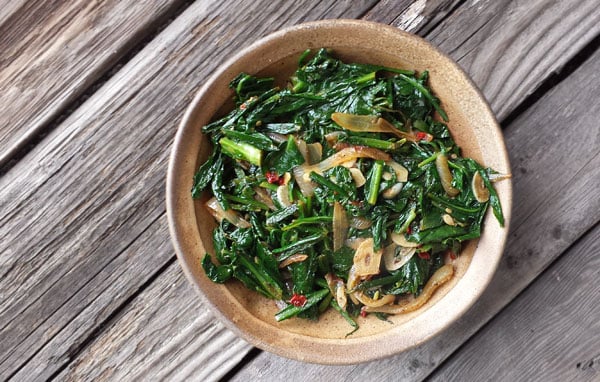
I have a special love for the tonic greens of spring. Dandelions of course, but also their cousins, prickly lettuce, cat’s ear and wild chicories. All are pleasingly bitter, a bracing counterpoint to sweet greens like miner’s lettuce, or tart greens like curly dock, or pungent greens like wild radishes and mustard. I can hear you: Bitter? Why would anyone want to eat bitter food? Walk with me a moment.
You’re not crazy for your concern. Bitter is normally a biological alarm, an indicator that the plant in your mouth is not fit to eat. But there’s bitter and there’s bitter. Chow down on anything in the artemesia clan — this one includes wormwood, of absinthe fame — and you’ll know real bitter. As in all things, timing is key.
You want to be foraging for wild greens in early spring, before the days get much warmer than, say, 80°F, when the greens on these plants are still young, fresh and nice to eat. Once the weather warms, however, they all become impossibly bitter. Every year I get a note from someone telling me I am full of it because I talk about eating dandelions a lot. “Well, I tried them,” the letters always start. “And they were so bitter I spit them out! How can you tell people to eat such things!” Typically, those notes arrive in July or August. Remember folks, to all things a season. This is the time.
Most people have some idea what these greens all taste like. If you don’t, you can get similar greens in the supermarket. Try chicory, escarole, frisee — and yes, people are cultivating dandelions now, too.
How do you eat them? Cooked, for the most part, like chard or kale. Bitter greens like fat and onions. Bacon, olive oil, butter, grated cheese. Onions, garlic, and chiles if you like them. A splash of citrus or vinegar right at the end completes it. They also like tomatoes a lot. Eat them as I did in the picture above, maybe with some pasta or crusty bread, and you’ll see.
So. How to find and identify them?
First, walk outside your house and look around. Chances are you have these plants on your property. All like disturbed ground, which means places where the soil’s been chewed up recently. Roadsides, edges of your landscaping, construction sites, snack dab in your garden.
When you look for these plants, you do need to be sure to watch out for potentially compromised areas: Roadsides and trail edges are often sprayed with pesticides, and vacant lots can sometimes be that way because they’re on toxic soil. An old house site is probably fine, an old dry cleaning shop most definitely not. I pick mine around my yard and at the edges of my garden; I don’t use pesticides, so I’m safe.
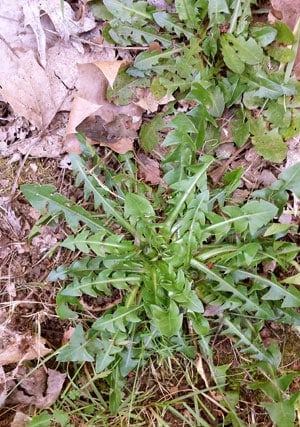
What are you looking for? Dandelions. Most of these plants that aren’t actually dandelions look kinda-sorta like dandelions. They are all rosettes, all have serrated leaves to some extent, and all will send up a central flower stalk; dandelions send up several.
I am assuming you know what a dandelion looks like. If you don’t, it’s the plant in the picture on the right. The leaves are the giveaway, although they are extremely variable. See how the plant radiates around a central point? This is called a rosette. All of the greens I am talking about in this post do that.
How big are they? Size varies wildly. These dandelions are pretty small, about 7 inches in diameter. They’re living at the corner of my yard, and get no extra water. I had one in my garden last year that was in rich soil and got regular water: It was more than a foot across, with lush leaves.
This brings me to another point. The more hardscrabble the environment, the more bitter the plant. The garden dandelion was so mild I could sit there and eat it raw. The dandelions pictured are a bit too bitter for that, but are wonderful cooked.
Bitterness is a reaction to stress, which is why in high summer, a time of heat and water stress, these plants get so unbearable. And in general, when they are flowering, the greens are going to be more bitter.
You can pull up the whole plant if it’s in a place you don’t want it to be in — storing it in the fridge root and all will keep the greens fresh for two weeks — or your can cut leaves for a dish and leave the plant where it lies. The root is essentially the same thing as root chicory, and you can make a very good coffee-like drink from them. (Instructions for this here.)
Dandelions are easy. Let’s move on to its relatives.
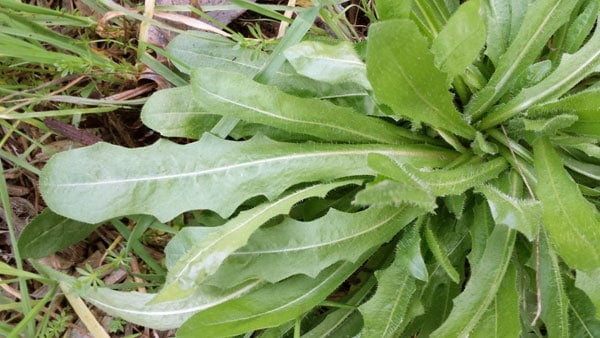
This is cat’s ear. Why it has this name I have no idea. Maybe because the leaves are fuzzy? Hypochaeris radicata is also called a false dandelion because the leaves are similar and it sends up a flower similar to the dandelion; both plants are in the aster family. From a cook’s perspective, they are basically the same thing.
Unlike dandelions, which live in every state, cat’s ear is absent from the desert Southwest and the Great Plains. It does happen to be more common than dandelions here in Sacramento. The leaves can be used just like dandelions, but the roots tend to be smaller and more diffuse — you tend to not get the big taproot you see on a dandelion. One neat thing to do if you have lots of cat’s ears around is to gather the flower buds, along with about 4 inches of the stalk, and cook them as you would asparagus. Snap them off like asparagus, too. (I learned this trick from fellow forager John Kallas, in his excellent book Edible Wild Plants: Wild Foods From Dirt To Plate.)
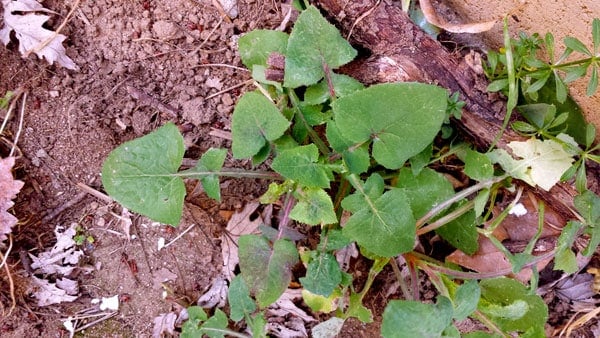
Another dandelion look-similar is the sow thistle, Sonchus oleraceus. This one can easily be mistaken for a dandelion when it’s young, but you’ll never make that mistake once the plant matures. When it’s young, like the photo above, you can eat it like any dandelion. But as it’s name implies, when sow thistle matures, everything about it gets spiky. It sends up a gnarled, leafed center stalk that develops small, dandelion-like flowers all over it. I include this one mostly because people pick it thinking it’s dandelion, which is fine from a cook’s perspective.
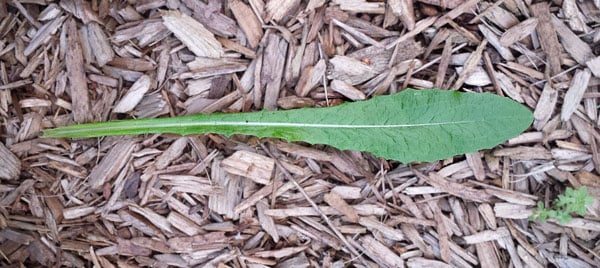
Finally, we get to prickly lettuce and actual chicory. My yard happens to be, ahem, well-stocked with Lactuca serriola, which Holly and I call “man lettuce,” because when it’s full-grown it can grow as tall as a man. Both plants are European natives are can be found in every state. The photo above is from a young plant, which is when you want to eat this thing. Older leaves are more serrated like a dandelion, thick, dark green and, as you might imagine, prickly.
Prickly lettuce is a large plant right from the get-go, with rosettes normally a foot or more in diameter. It won’t have a thick taproot like a dandelion. It has a mass of thinner roots like a grass that surround a very thin, very long taproot you will never fully extract. This is how the plant can live in California’s arid summers — it will often be one of the last green things standing in July. You don’t want to eat it then, although if you boiled the leaves in a couple changes of water I suppose you could if you had to. This is what the leaves look like when you want them:
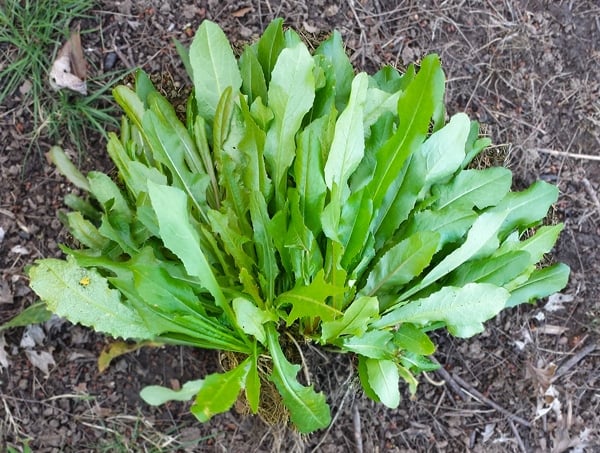
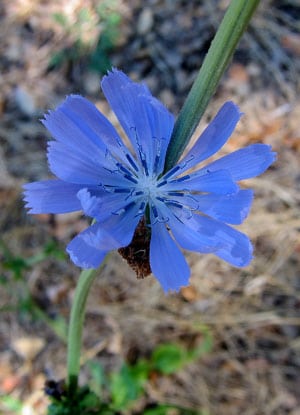
Chicory itself, Cichorium intybus, isn’t often used as a leaf vegetable, not because of flavor, but because at least here in America, this plant is the roadside weed par excellance. I have found it in clean areas, but rarely. If you do find it, good luck differentiating the leaves from sow thistle, prickly lettuce or even sometimes dandelions. Chicory has crazily variable leaves, and I’ve seen it masquerading as any of the other plants in this article. Luckily, you need not care as a cook.
One thing that sets chicory apart from every other plant in this article is its flower. Every other plant listed here has a yellow “dandelion” flower of varying sizes. Chicory, on the other hand, has pretty, sky-blue flowers that are often the last flowers of our spring, blooming even into July. Chicory can do this because it too has a serious taproot — and unlike the taproot of prickly lettuce, chicory’s taproot is well worth digging for coffee. If you want to do this, look for the flowers in summer, and mark the spot. Come back to it in autumn, when the plant begins to die back and the rains have loosened the soil.
So get out there and eat your lawn. You have until the weather heats up to do it, and if you miss your chance, fear not: Late fall is the second best time for gathering these tonic greens.





This article was fantastic, thank you! I had never considered the stress element before, but now that I’ve read it, it makes so much sense — lettuce and other greens in the garden gets bitter when they flower or the weather gets hot, why wouldn’t that be the case for wild greens?
Such a simple concept but it’s going to level up my foraging game considerably. I’m very glad I found this blog!
I’ve tried dandelions several times over the years and not cared for them, but retrospectively I realized reading this I’ve always harvested them too late to keep them palatable. So earlier this spring I collected a large harvest of dandelion leaves and sow thistle. Not only was it a great way to weed, but use the weeds for tasty greens! Just a general sautée with onions & garlic, salt & pepper, and finished with a little red wine vinegar was delicious and even our teenagers enjoyed them. That’s really saying something when our 14 year old anti-greens boy said they were really good! Thanks for the awesome article!!